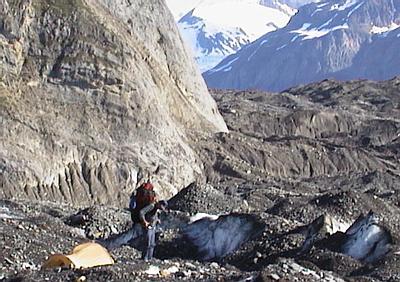6 July, 2000
July 6, 2000
The lake continues to rise at 2-3 feet per day. It is significantly higher
than when it broke out last year. Where we are camped, the ice can be heard
thumping and groaning as it is compressed by the rising lake. Sometimes this
can be heard/felt in the ice directly beneath our feet. It is pretty strange
stuff. The ice is being compressed here because the front of ice that
adjoins the lake is being uplifted and floated by the rising lake. The
effect is to translate compressional forces into the ice away from the lake.
It is similar to pushing up on a diving board.
We drilled to 242 meters (about 680 feet) in our third borehole today. We
think we are either at, or very close to the glacier bed. These are great
results because the drill only got to 160 and 140 meters in the previous two
boreholes. We could not drill further in these holes with the hot water
drill because rocks that had collected in the bottom of the borehole
obstructed the drilling. Our third hole will be instrumented with a pressure
transducer with the hopes of some interesting water level measurements
before, during, and after the flood.
University of Washington seismologist Steve Malone reluctantly left camp
today. He had a professional meeting to attend. He is on the research
faculty in the Geophysics Department at the University of Washington and
monitors an extensive seismic network for the Pacific Northwest. Volcanic
seismology is his specialty. Even though the shipping company messed up
sending his seismic equipment that he was going to be installing for this
project, he still chose to join us on the glacier for 5 days to help out with
the various aspects of the work. He placed surveying stakes for Dennis
Trabant, and helped him set up the GPS (global positioning system)
instruments. He worked with St. Olaf undergraduate Andrew Malm gathering ice
radar data. He helped set up camp, and he and I worked together a couple of
evenings to prepare some pretty decent dinners. Wish you could have stayed
for more Steve.
A couple of hours later Neil Humphrey arrived in camp. He is a glaciologist
at the University of Wyoming and owns the hot water drilling equipment that
we are using for this project. He came o check things out and see how the
drill was working. Or, as PI Andrew Fountain said, "He came to make sure we
are not abusing his drill". When he arrived, all systems were go - two
diesel motors, a hot water generator, a sump pump, and a hose of hot water
extending 180 meters into a borehole. And sure enough, one of the first
things he did (after eating lunch and catching up with Andrew) was check all
of the workings of the drilling equipment - opened toolboxes, listened to
motors, read various gauges, pulled on hoses. His assessment: "Everything
seems to be working beautifully".
If you want to see pictures of the various aspects of this field experience
check back later in the summer - they will appear when I return from the
field.

University of Washington seismologist Steve Malone shoulders his pack for the hike out of our camp to a nearby landing strip. He will hike about one mile through the rocky area in the right of the photo.

Contact the TEA in the field at
.
If you cannot connect through your browser, copy the
TEA's e-mail address in the "To:" line of
your favorite e-mail package.
|
